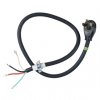Redoctober
Well-Known Member
I was wondering if there is a special advantage to having 220v lights as opposed to the normal 110v we are used to in the USA. Reason I ask is that I bought a Gavita light and I think its absolutely awesome but I run it off of a step down transformer which I'm told you're not really supposed to do. If I were to continue using it and maybe buy another, I would have to rewire my socket for 220-240v, and I guess I am wondering if it's worth it? Or should I just buy regular 110v ballasts? Gavita has a special reputation, and they make amazing lights, but they don't make lights in 110v models.

